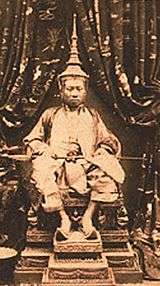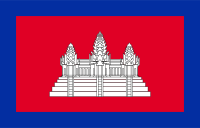Norodom of Cambodia
| Norodom | |
|---|---|
 | |
| King of Cambodia | |
| Reign | 19 October 1860 – 24 April 1904 |
| Coronation | 3 June 1864 |
| Predecessor | Ang Duong |
| Successor | Sisowath |
| Born |
February 1834 Angkor Borei, Cambodia |
| Died |
24 April 1904 (aged 70) Bangkok, Siam |
| Spouse | 47 wives[1] |
| Issue | 61 sons and daughters |
| House | House of Norodom |
| Father | Ang Duong |
| Religion | Theravada Buddhism |
Norodom (Khmer: នរោត្តម), known previously as Ang Voddey (Khmer: អង្គវតី) (February 1834 – 24 April 1904), ruled as king of Cambodia from 1860 to 1904. He was the eldest son of King Ang Duong, who ruled on the behalf of Siam, and half-brother of Prince Si Votha as well as the half-brother of King Sisowath. Norodom was considered to be the first modern Khmer king. He was credited with saving Cambodia from disappearing altogether. In 1863, to prevent the two powerful neighbours, Vietnam and Siam, from swallowing Cambodia altogether he was invited by France to make Cambodia its protectorate. However, he sent many letters to Siam claiming French Admiral de la Grandière had forced him into signing a false treaty. Many Cambodians believed that this brilliant act and his shrewdness did actually save Cambodia from disappearing. His reign of 43 years is the longest in the modern era.
When he was born, Cambodia was under Siamese rule, the royal family, being related to the Siamese. Nonetheless, The royal capital of Cambodia was in Oudong (named for the first King of Ayutthaya), but the main center of the area was the capital of Siam in Bangkok. Prince Norodom was sent by his father to study in Bangkok, where he studied Siamese (Thai), Politics, Military, Buddhist scriptures and the ancient Pali language.
Name

Norodom's royal name was Norodom Prohmbarirak (Khmer: ព្រះនរោត្ដម ព្រហ្មបរិរក្ស), previously, Ang Reacheavoddey (Khmer: អង្គ រាជាវតី). He is referred to as Ang Voddey in some Western accounts. His posthumous title is Preah Karuna Preah Sovannakaot (Khmer: ព្រះករុណាព្រះសុវណ្ណកោដ្ឋ).
Rule
In 1850, Norodom and his half-brother Prince Sisowath were sent to study in Bangkok by their father Ang Duong, which they have been patronized by the royal family of Siam. In 1857, Norodom (Prince Phrom Borirak) served in the Royal Siamese Army as a military adviser, for which later he was awarded the Order of the White Elephant.
In 1860, when King Ang Duong died, Norodom became his successor but remained uncrowned because the Siamese royal court refused to release the Cambodian royal regalia, which made Norodom only adviser of the Siamese king.
At the same time, King Norodom inherited a major Cham rebellion against Khmer rule which his father began to put down but died before he could defeat them. In 1862, Norodom lost control over the region, abandoned the capital of Oudong and fled to safety in Battambang (though the capital was still at Oudong). He later fled Cambodia altogether and went into exile in Bangkok. Seeing that the Siamese and Vietnamese overlords had gotten Cambodia into civil strife, in 1863 Siamese royal court decided to appoint Norodom as ruler of Cambodia, The Coronation was held in Bangkok at the Wat Phra Chetuphon, but Siamese still keep the royal Cambodian regalia in Bangkok, Siamese let Norodom reside in Battambang that was easily for Siamese control. after the large part of Vietnam became French protectorates, on July 15, 1867, the French forced Siam to cede Cambodia to France by signing a treaty, the Royal Siamese court accept the claim of France because of the powerful military of France, the French also forced King Norodom to return to Oudong in 1867 and sign a treaty of protection with France. This transferred the country from Siamese to French colonial rule. Cambodia thus became an independent French protectorate, though it was highly autonomous.
With Cambodia a French protectorate, the Siamese royal court agreed to send the royal Cambodian regalia and let Norodom be crowned king under the French protectorate. In 1868 Norodom was crowned again, the coronation being supervised by the French officials. Nonetheless, the young king began his rule over a country in civil turmoil. However, the country was weak and subject to the power struggles between France and Siam. Not only were there rebel groups intent on getting the Siamese and the French out of Cambodia, but also bandit groups.
Nonetheless, in 1884, France took control of Laos and overran Vietnam. France and Siam entered into the Franco-Siamese War (1893) over Laos, ending with a treaty ceding Laos to France after the French blockade of Bangkok. In 1907, Siam ceded Battambang and Siem Reap, its last claim in Cambodia after continued pressure from France.
French protectorate
On June 17, 1884, French authorities forced King Norodom to sign a treaty which consolidated their position in Cambodia by forcing the King to give up control of public revenue, customs taxes and public works. Norodom resisted but with French gunboats anchored outside the Royal Palace he had no choice but to sign. The French actions cause widespread anger throughout the country. In 1885 Prince Si Votha, Norodom's half brother led a revolt against the French rule. The French suspected that Norodom was secretly supporting Si Votha's actions and the French blamed him for inciting the revolts. The revolt ended when the Cambodians were assured by King Norodom that the French had offered concessions to him. After the restoration of the 1885-1886 revolt, Norodom was in a position of temporary strength. To prevent another revolt, the French was less inclined to force the king to the wall once more.
Following the Sino-French War (1884–1885), French Indochina was formed in October 1887 from Annam, Tonkin, Cochinchina (who together form modern Vietnam) and the Kingdom of Cambodia.
For the remainder of his rule Norodom was a puppet of the French. Before he died in 1904, he appointed his son, Prince Yukanthor, as heir apparent to the throne. But Yukanthor had a fall-out with the French and did not succeed to the throne. The French moved the capital from Oudong to Phonm Penh. Norodom could do nothing to prevent this, French also forced Norodom to change his religion into Christianity, the French continued to change Cambodian tradition into Western style, this make Norodom opposition with French governor Henri Félix de Lamothe. Until the French had supported his Francophile half-brother Prince Sisowath to be king instead him, Norodom decided to be exiled in Siam, and he died in 1904 in Bangkok. Siamese royal court under Chulalongkorn reign decided to return his body to Cambodia, his body was cremated in the traditional Buddhist fashion in 1906 in Phnom Penh.
He was succeeded by Prince Sisowath.
Reforms
Throughout Norodom's reign, several administrative and judicial reforms were improved in the kingdom. The reduction of provinces were imposed to help reduce administrative costs. He also abolished commercial monopolies, slavery, and civil lists for the royal family. During his reign, certain agricultural products such as betel, pepper and sugar costs were reduced.
Legacy


King Norodom was remembered for his appreciation and fondness of the arts. It was under his supervision that the Silver Pagoda was built in 1892, as well as Wat Oudong consecrated on 6 June 1875. When Norodom assumed the throne in 1860, classical dance recovered some of its ancient prestige, and soon became a great honor for court officials, ministers and senior dignitaries to have their children admitted to the palace's school of dancing.
In 1872, Norodom went on an official visit to Hong Kong, Manila and Singapore. In Manila, the King was greatly impressed by the music skills of the Filipinos and decided to take some musicians back to Cambodia to teach modern music. The Norodom's generosity began drawing artists from many nationalities to Cambodia and they were always given a warm welcome at Royal palace and court. Most of them had a deep interest in the Royal Ballet and thus were given every opportunity to learn Khmer music and dance.
Under King Norodom, the beginnings of the Royal Khmer Navy was established for territorial protection.
Honours
- Grand Croix of the Légion d'honneur-1872 (Grand Officier-1869) (Chevalier-1865) (France)
- Knight Grand Cross of the Order of the White Elephant (Siam)
- Knight of the Order of the Maha Chakri (Siam)
References
1. Encyclopædia Britannica.com 2. Milton E. Osborne, The French Presence in Cochinchina and Cambodia
| Norodom of Cambodia House of Norodom Born: February 1834 Died: 24 April 1904 | ||
| Regnal titles | ||
|---|---|---|
| Preceded by Ang Duong |
King of Cambodia 1860 – 1904 |
Succeeded by Sisowath |
